(This article is the outcome of a project collaboration between the Tang Prize Foundation and Pan Sci Taiwan)
Chinese original by Yong-Syuan Wun
Edited by Yu-Han Wong
On September 22nd, 2018, the recipients of the third Tang Prize came together in Taipei to enrich the day with eight edifying lectures that began with a discourse on rule of law and concluded with a speech on Sinology. In accord with their own areas of expertise, the laureates provided professional advice on how to enhance academic research and the development of society. Sharing the fruits of their labor and giving helpful guidance to young scholars, these winners are the epitome of virtues and virtuosity, whom to the end of time we shall neither forget nor stop emulating.
How a government ruled by law can safeguard civil rights—Professor Joseph Raz
Differing from scholars of substantive law, Prof. Raz is an original thinker on legal theories. Entitled “The Law’s Own Virtue,” his lecture offered a dissection of “the nature and role of rule of law[i]” as well as “its essential properties,” detailing the many principles that underpin rule of law.
[i] Unless otherwise specified, all the quotes are taken from the laureates’ lectures.
.jpg)
“Government is by law…first, reasonably clear; secondly, reasonably stable; thirdly, publicly available; fourthly, general rules and standards that are fifthly, applied prospectively and not retrospectively,” Prof. Raz expounded. With all these requirements met, a government should also safeguard the rights of its citizens, for the aim of rule of law is to militate against the existence of an authoritarian regime, and to know whether or not we have an “arbitrary government” is to see whether it promotes “the interests of the governed.”
However, Prof. Raz pointed out that “not every failure of the government to be guided by the law is a breach of the rule of law.” Though rule of law can guide governmental actions, it is inevitable that “governments have considerable discretionary power.” Therefore, it is incumbent on citizens to apply logical thinking, exercise their judgement, or even resort to protests, to keep the authorities under rigorous scrutiny and to push them to reform.
In addition, the fact that rule of law can unite “cultures that otherwise differ” doesn’t guarantee its universality. On the contrary, it should be adapted to established conventions of any region, nation, or autonomous organization and should not be seen as “a manifestation of one culture imposing its norms on others.” The adaptability of rule of law is not only a condition for “world-wide cultural and economic exchanges” and for a relationship based on reciprocity. It is also a foundation for the creation of diversity in different societies.
There is no doubt that the building of a well-ordered society in the modern era is premised on the observation of rule of law. Nonetheless, it is essential to remember that “the principles through which the rule of law is applied allow considerable room for flexibility and adaptability,” for such is a prerequisite for its being able to fulfill the needs of different governments and their peoples as well as to perform its most important function: defending “the interests of the governed.”
One small step no one noticed, one giant leap for research on the etiology of cancer — Dr. Tony Hunter
The 2018 Tang Prize in Biopharmaceutical Science was centered on cancer treatment, and Dr. Tony Hunter, whose research findings opened up the field of targeted therapies and won him the Tang Prize, was the first among the three winners in this category to address the audience.
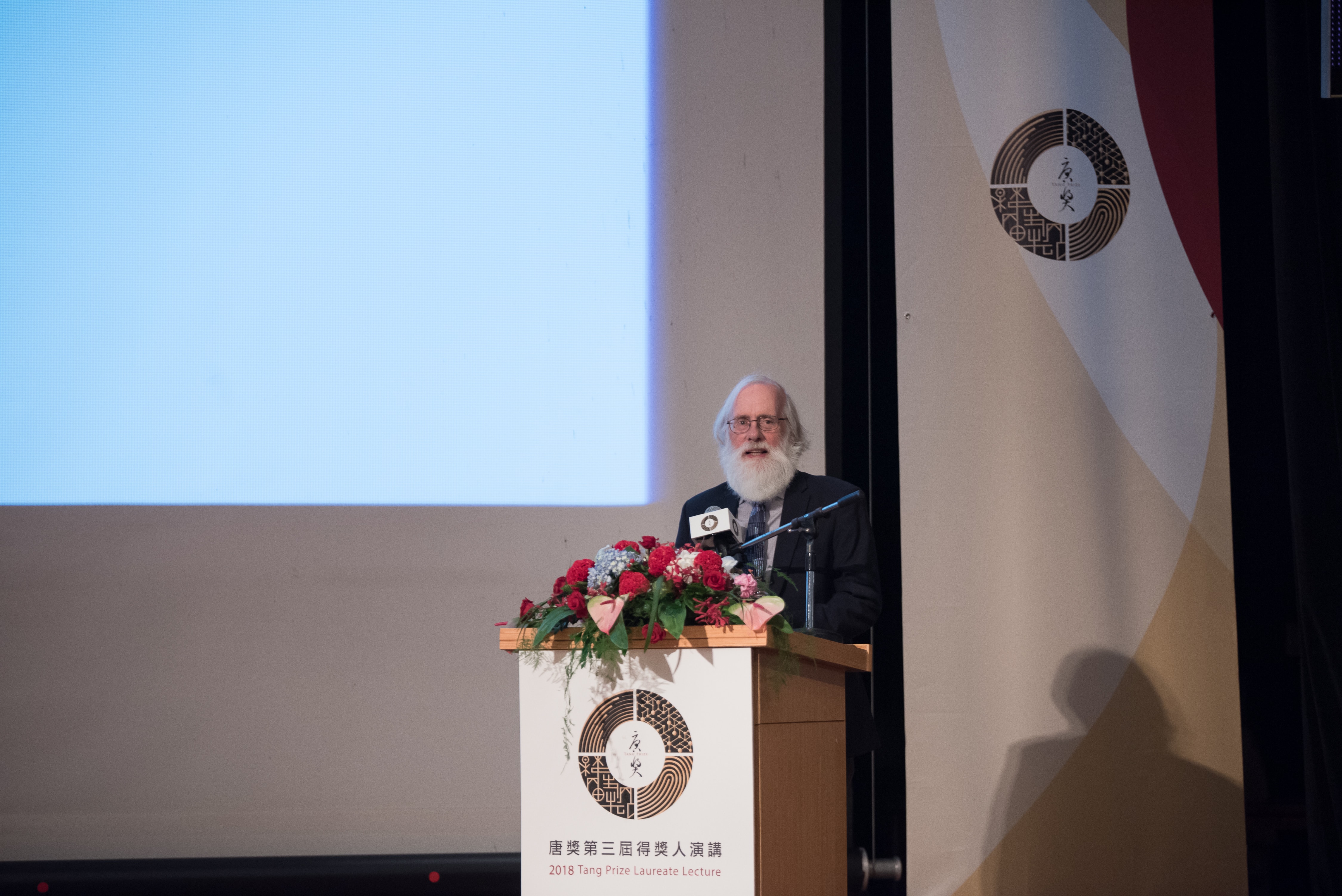
Many important research findings start as an accident, to which Dr. Hunter’s discovery of tyrosine kinases bears clear testimony. When trying to “find out which amino acid was phosphorylated,” he stumbled across the mechanism of “tyrosine phosphorylation” because he was “too lazy to make up a fresh (electrophoresis) buffer” and the pH value of the buffer he “had used many times before” was changed, thus allowing “phosphotyrosine to resolve from phosphothreonine.” In his lecture, Dr. Hunter also shared an array of research outcomes he produced since 1979, giving the audience a glimpse of his considerable accomplishments over the past 30 years.
Tyrosine kinases are proteins that play an important role in cell signaling. Any aberrant tyrosine kinase activity could lead to abnormal cell growth. In the initial stage of his discovery, Dr. Hunter confirmed that the polyomavirus middle-T transforming proteins were tyrosine kinases, indicating a possible link between tyrosine phosphorylation malfunction and cancer. This postulation was later proven correct as he informed us that “it became clear from surveying the literature that mutations in protein kinases would be causal in a fairly large number of diseases and particularly in cancer.”
This research increased our understanding of the cause of cancer by leaps and bounds and paved the way for the development of targeted cancer drugs. Subsequent research efforts have gone into identifying tyrosine kinases and “when the human genome was completely sequenced in 2002…it turned out there are 90 tyrosine kinases.” In the second part of the talk, Dr. Hunter mentioned two on-going projects in his lab, one of which is their work on developing “better therapeutic treatments of pancreatic cancer, one of the most devastating cancers largely because it’s usually diagnosed so late.” He hoped that by drawing on the past experience of uncovering the basic mechanisms underlying cancer, scientists would be able to find more effective treatments.
Turning cancer into an infectious disease: once lethal, now curable—Dr. Brian Druker
Jointly awarded the Tang Prize with Dr. Hunter whose discovery constituted a key element in his own research, Dr. Brian Druker set out on his journey to the development of a small-molecule tyrosine kinase inhibitor in the 1990s with the aim of treating chronic myeloid leukemia (CML), a journey that gave birth to one of the first targeted cancer drugs: imatinib (Gleevec®).
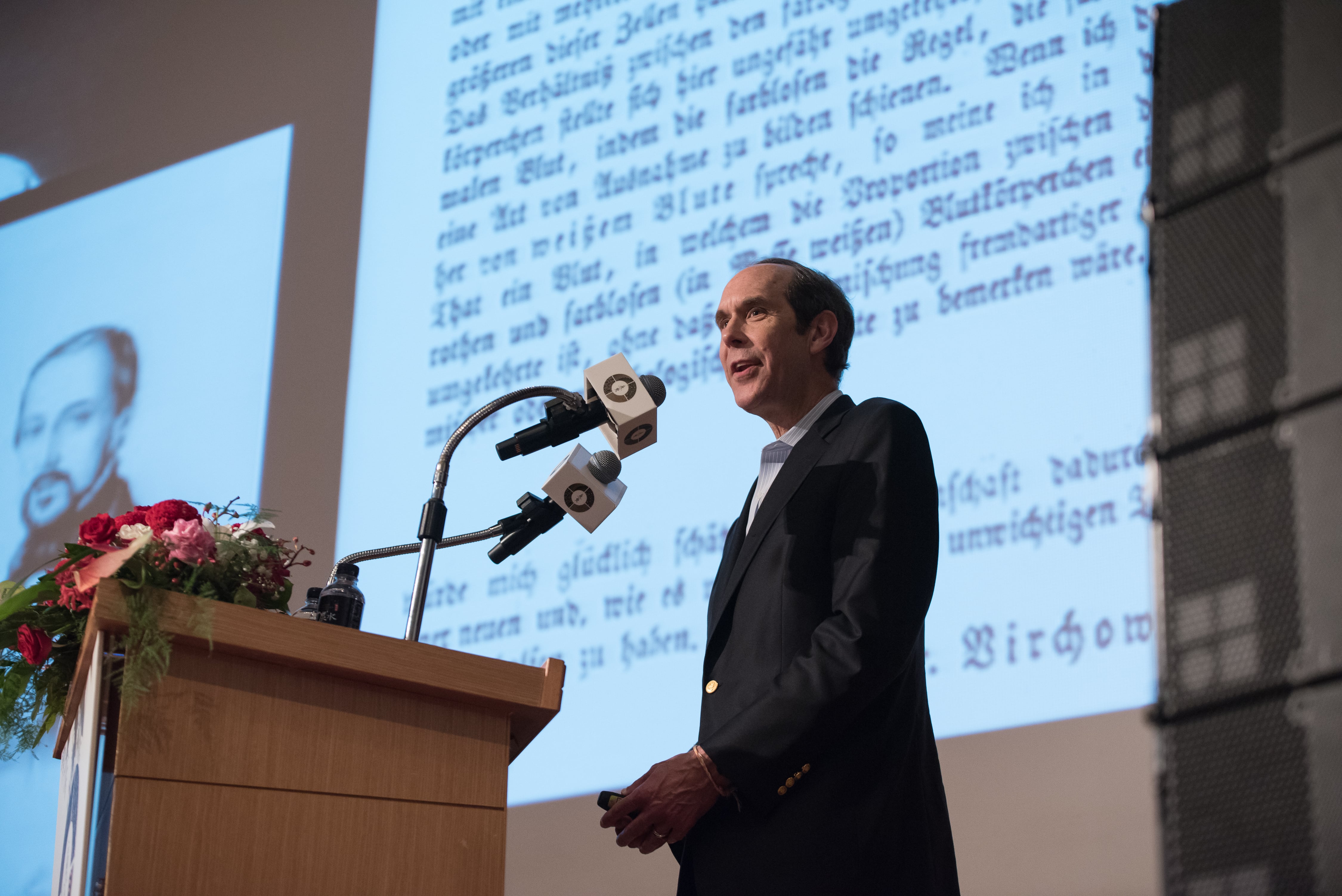
When a chromosomal translocation in our blood and bone marrow occurs and creates an oncogenic tyrosine kinase called Bcr-Abl, white blood cells will overproduce massively. This molecular abnormality is known to be the cause of CML. Even though as early as 1845 there were already published clinical descriptions of CML, it wasn’t until the 1980s that scientists arrived at a proper understanding of the mechanism of this type of cancer. Beginning his lecture by tracing the history of the studies of CML, Dr. Druker then went on to recount his own story of developing imatinib.
Imatinib was the first small-molecule tyrosine kinases inhibitor approved by the US Food and Drug Administration, and it has miraculously increased the five-year survival rate of Dr. Druker’s patients to over 90%. While the major cause of 60% of the relapses “are mutations in the Bcr-Abl kinase itself,” Dr. Druker assured us that there was no reason for despair, because, on the one hand, to treat patients in the early stages of the disease can dramatically reduce the possibility of relapses. On the other, the second and third generations of targeted therapies have been developed subsequently.
In spite of the success of imatinib, Dr. Druker stressed that the development of targeted cancer therapies was still in the embryonic stage. Thinking about more effective future approaches, he suggested “taking a patient sample and characterizing the tumor extensively. Not only the tumor, but the surrounding microenvironment,” in order to help doctors make treatment decisions as soon as possible. Moreover, the data collected from relevant research works can be used for cancer prevention and early diagnosis. “Not to get it in the first place” or to “treat it early,” he reminded us, should be the core of all cancer therapies if we want to increase survival in cancer patients. Sounding an optimistic note throughout his lecture, Dr. Druker pointed out that we have converted infectious diseases from something lethal a century ago to something curable, and now as cancer “has been converted to a manageable condition,” he was confident that major breakthroughs would be achieved within the next one hundred years.
20 years’ hard labor to win monoclonal antibody due recognition— Dr. John Mendelsohn (lecture delivered by Dr. Mien-Chie Hung on his behalf)
The MD Anderson Cancer Center’s reputation in the evolution of cancer treatment has been set in cement by the fact that one out of three cancer drugs approved by the US Food and Drug Administration (FDA) has its clinical trial run in this center, and it owes much of its success to Dr. John Mendelsohn, another towering figure in cancer research and one of the 2018 winners for Biopharmaceutical Science. Therefore, in the third lecture that concluded this section, Academic Sinica Academician Dr. Mien-Chie Hung, representing Dr. John Mendelsohn, gave a talk that provided us with a window on his extraordinary achievements.
In early 1980s, Dr. Mendelsohn and his colleague Dr. Gordon Sato proposed a hypothesis that the inhibition of EGF (epidermal growth factor) receptors could be an effective cancer therapy. He then went on to develop a monoclonal antibody aimed to suppress tyrosine kinase activities.
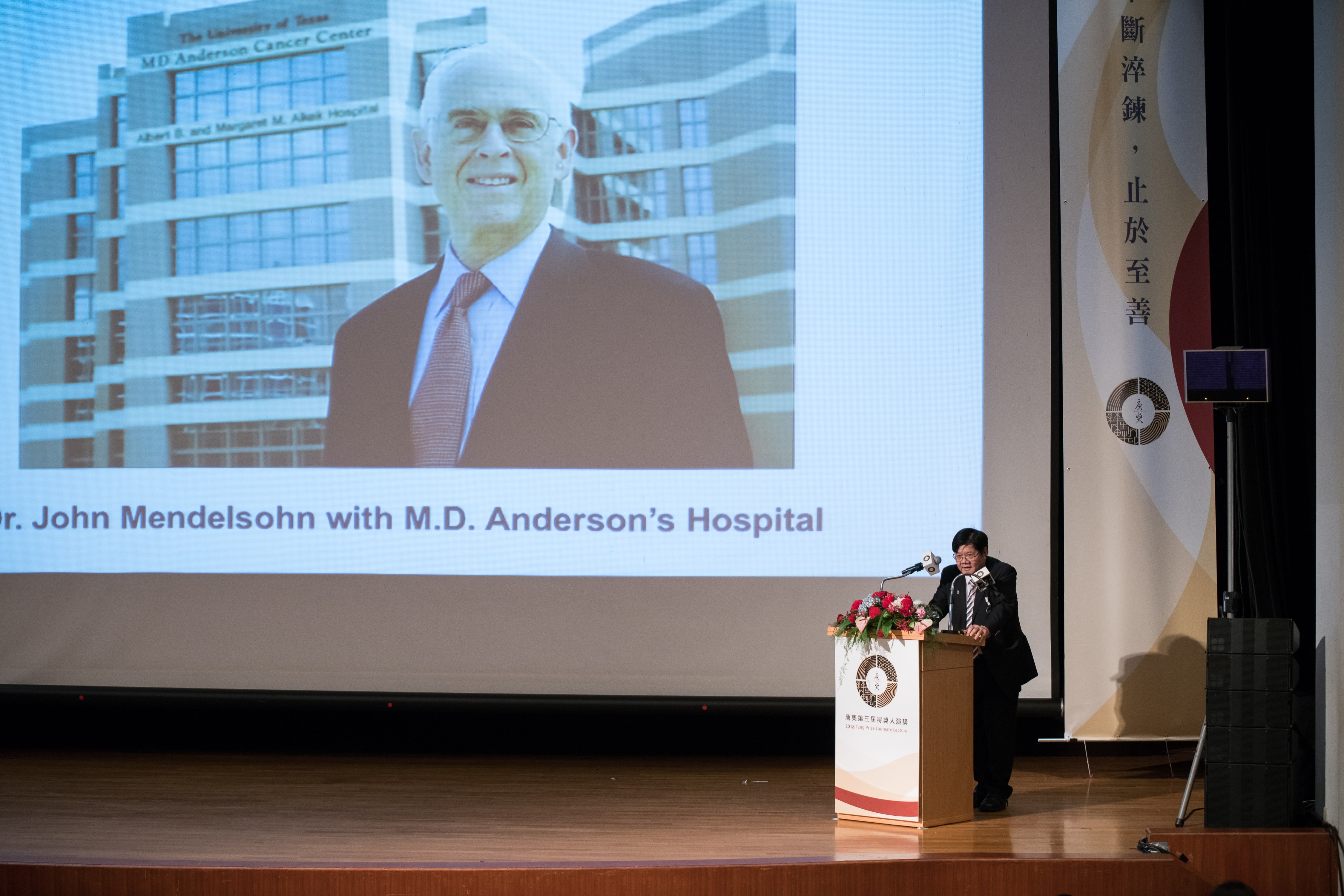
Time has proven that monoclonal antibodies are an effective strategy for treating not only cancers but also many other diseases. The irony is that when they first put forward this proposition, many in the medical world were skeptical about it, and no one was willing to fund their research. It took Dr. Mendelsohn and Dr. Sato 20 solid years to develop the monoclonal antibody, C225, and had it approved by the US FDA.
Because they never gave up, now patients with colon or head and neck cancers can be treated with a targeted therapy called Erbitux®. Many research efforts have since ensued and made possible the development of a wider range of monoclonal antibody drugs. Dr. Hung emphasized that monoclonal antibody therapy has come a long way from raising doubts to earning recognition. For this reversal of public opinions to have happened, Dr. Mendelsohn, Dr. Sato and the entire scientific community should pat themselves on the back for the earnest endeavors they have made.
Human beings’ battle against cancer is always going to be a long and hard-fought one. Fortunately, while we wait for the wonder cure to be found, the perseverance of these scientists at least allows for the hope that one day this horrible disease will be defeated.
Leaving young people “a feasible task and tools” to tackle climate change—Dr. James E. Hansen
Nowadays, global warming is seen by many as a grave situation both academics and the general public have to be duly concerned about, and the people bringing this pressing issue to the fore are none other than Dr. James Hansen and his research team who already felt a deep foreboding of the impact of the man-made greenhouse effect 30 years ago.

Dr. Hansen made an analogy in explaining climate science to the audience, saying that “adding CO2 to the air is like throwing another blanket on the bed. It reduces Earth’s heat radiation to space, so there is an energy imbalance.” For several years, his research team distributed more than 3000 Argo floats around the world’s oceans to measure their heat content. The data they obtained indicated something very worrisome: “the upper ocean is gaining heat at a substantial rate” and “the total energy imbalance…is equivalent to exploding about 500,000 Hiroshima atomic bombs per day, 365 days per year.”
In 1981, Dr. Hansen and his colleagues published an article suggesting that the future trajectory for global warming could be an aberrant one. The prognosis was that “warming would exceed natural variability…the 21st century would see…erosion of ice sheets, rising sea levels,” and then a chain reaction could erupt. These gloomy predictions convinced Dr. Hansen that it was his moral duty to help people understand the danger of the human-caused greenhouse effect. He also found out that “the measured energy imbalance occurred…when solar energy reaching Earth was least,” which, contrary to the argument of some climate change deniers who laid the blame on the sun, enabled Dr. Hansen to convey the view that fossil fuel burning is the main culprit of climate change.
30 years have gone by, and many of what was foretold in Dr. Hansen’s article unfortunately came true. The increase in human CO2 emissions has aggravated global warming. Moreover, he realized that even though nuclear power can potentially help reduce our carbon footprints to zero, its development has been agonizingly slow because many people are concerned about “health effects of atomic radiation.” Stressing that he didn’t endorse “any specific technology” but wanted to achieve “rapid phasedown of CO2 emissions,” he hoped we could find other ways to generate energy than burning fossil fuels. While we are still trying to advance the technology for energy production, Dr. Hansen suggested that we increase carbon fee “to make the price of fossil fuels honest by including their human health and climate change costs,” impose the fee on industries with high fossil fuel consumption, and distribute the collected fee equally to all the legal citizens. “The crucial underlying requirement is a rising price on carbon” to discourage the use of fossil fuels, he explained.
It is estimated that 20% to 50% of species will become extinct as a result of human activities. In fact, the rising temperatures of the world’s oceans have caused irreversible damage to at least one type of coral reefs each year. It is high time we stopped treating carbon reduction as a mere catchphrase and started rolling up our sleeves to get engaged and get things done!
The urgency of climate crisis calling for urgent actions from all of us –Prof. Veerabhadran Ramanathan
Another Tang Prize laureate who also devoted his life to research on global warming, Prof. Ramanathan was the first to discover that besides CO2, water vapor and chlorofluorocarbons (CFCs) are also substances that are heating up our planet. This discovery in turn shifted the focus of his research onto the investigation of other non-CO2 greenhouse gases, and, as he confessed to the audience, he realized that not only was the manmade greenhouse effect more detrimental than he thought but there were also more contributors to this phenomenon than he expected.
Using unmanned aerial vehicles, Prof. Ramanathan and his team measured the amount of sunlight coming into the planet and the amount of it radiated back to space. The data they obtained show that CFCs are also greenhouse gases. Comparing the atmosphere to a blanket, he pointed out that the thickness of this blanket varied, and while the planet ventilated its heat through the thin parts of the atmosphere, CFCs were there to shut off these windows “where the heat could escape.”
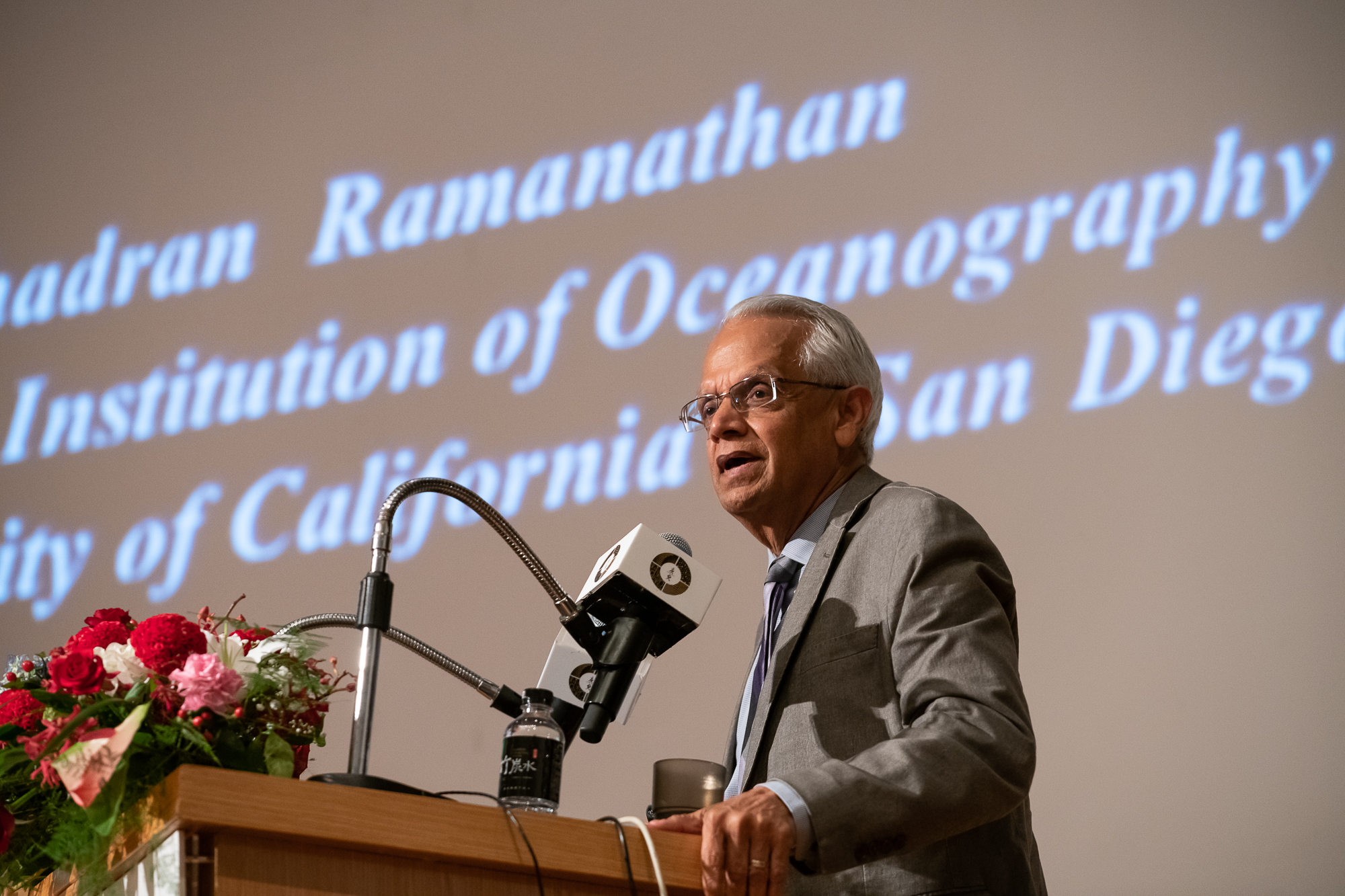
Even the seemingly innocuous water vapor is a greenhouse gas which traps heat. As global temperatures go up, more water evaporates and increase the atmospheric water vapor concentration, leading to more heat being trapped in the humid air. Due to this water vapor feedback, the likelihood of extreme weather continues to grow. Prof. Ramanathan also discovered some particular particles that are not greenhouse gasses but are “contributing to warming “as well: particles of black carbon, or soot (it comprises an air pollutant called particulate matter or PM, hence PM10 or PM2.5 we are now very familiar with when talking about air quality.) Soot comes from the incomplete combustion of hydrocarbons. It is “the black smoke you see from diesel and your cooking fire,” he reminded us. What’s more unsettling is that in some countries, the air carries a significant amount of black carbon, which sometimes even exceeds the CO2 levels.
Another pressing issue concerning global warming is that more land surface has been revealed since the snow in the polar regions started to melt. As a result, “the satellite data showed the planet is getting darker,” and without the snow surface reflecting sunlight back to space, the earth is absorbing more heat, making the whole situation even more dire. However, Prof. Ramanathan believed that if by 2050, we managed to keep the average temperature rise to 1.5℃, we could protect 1.7 billion people from exposure to deadly heat, reduce heavy precipitation by 1/3, and save more than 250 million people who could otherwise die from severe droughts.
With regard to how we can mitigate global warming, Prof. Ramanathan put forward several suggestions. Rather than focus on long-lived pollutants such as CO2 (a carbon dioxide molecule can exist for “centuries to millennia”), we can begin by cutting the emissions of short-lived pollutants such as black carbon and CFCs, as well as avoiding using coal as a heater or as a cooking fuel. Capturing methane from livestock manure and “burning it for fuel” also helps limit methane emissions. To redouble the efforts to combat climate change, Prof. Ramanathan has got together a team of experts from different fields, including physics, humanities, and engineering, to think up possible financial benefits that will encourage people to reduce their carbon footprints.
Drawing his talk to a close, Prof. Ramanathan admonished us to shoulder our moral responsibilities because “the situation has come to such a state we cannot just wait for top-down efforts. They are critical…Each one of us, we have to do what we can to keep the candle burning till the nations come to senses on this issue.”
Crossing academic boundaries and making Sinology the study of China for scholars of all nationalities —Prof. Stephen Owen
A chance encounter with Chinese poetry in a library left a 14-year-old boy with such a powerful impression that he later on became an outstanding scholar who knows how to approach Chinese literature from an innovative perspective. Though not having Chinese as his first language means Prof. Owen didn’t grow up surrounded by China’s rich cultural heritage, he nevertheless has the advantage of saying good riddance to lots of cultural baggage when trying to interpret China’s poetic works—all because of his different background.
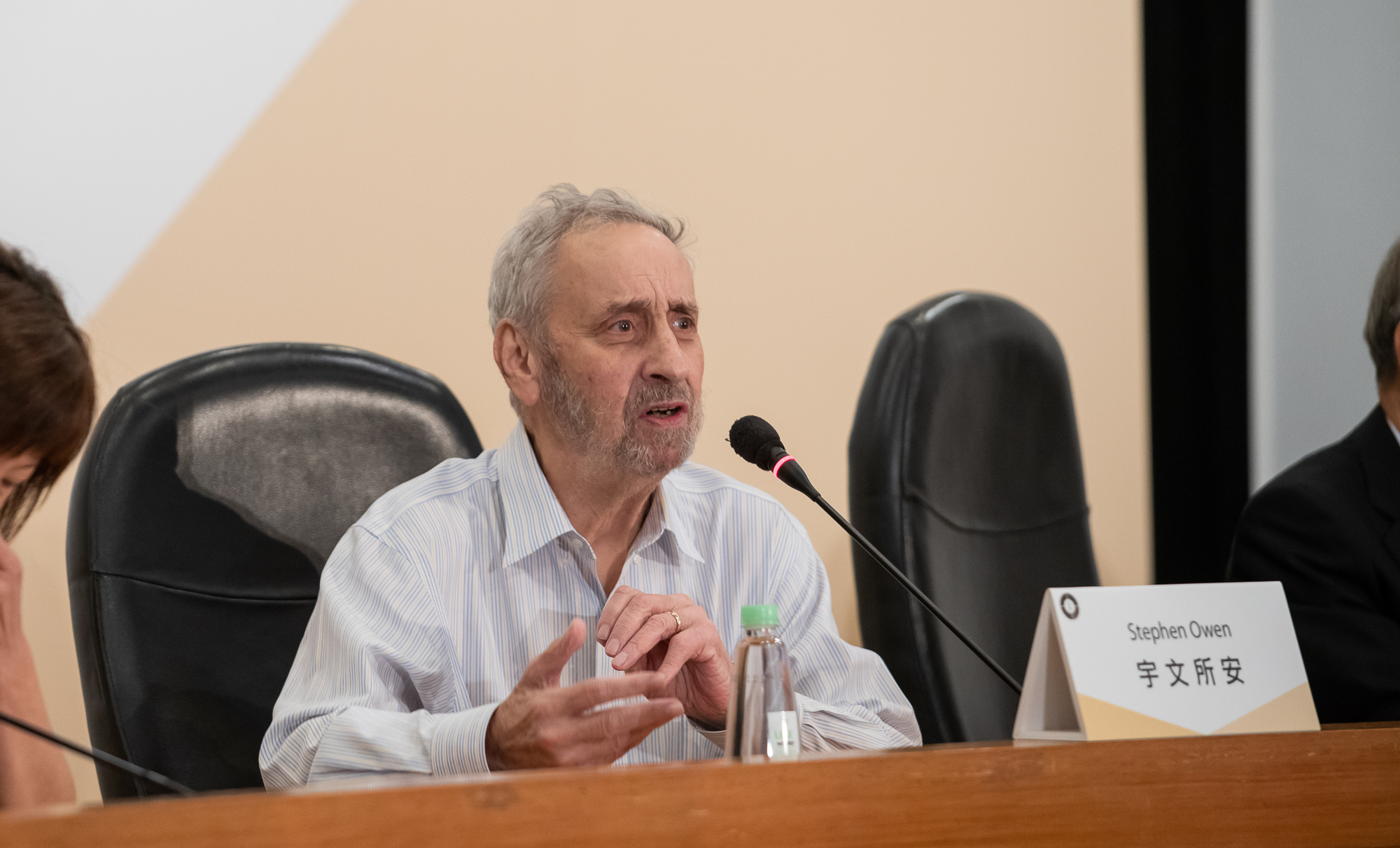
To elaborate on the title of his lecture, “Meaning in Literature: the Bamboo in the Breast and the Bamboo in the Belly,” Prof. Owen took Su Dongpo’s prose essay, “An Account of Wen Tong’s Painting of the Recumbent Bamboo in Yundang Valley,” as an example and drew on the lively bantering between three literati to explore the aesthetic and philosophical theories embraced by the intelligentsia in the Song Dynasty. Examining the society Su lived in and alluding to the fact that it was a country governed by literati, Prof. Owen remarked that whether a literary scholar in that era liked it or not, his aesthetic values would “become social value, which is commercial value. You can’t ever get away from it.” His interpretation of Su Dongpo’s essay thus demonstrated to the audience how an exposition on bamboo painting can become a vehicle for understanding the dominant values of a particular historical period.
Another reference Prof. Owen made was to “Lunbian,” a story about the Wheelwright Bian in Zhuangzi. He argued that though “Zhuangzi often used figures of death and deadliness,” he knew how to use fables and debates to strike a good balance between the serious and humorous tones of an article, thus preventing his writing from appearing too stilted. This style is unique to Zhuangzi. Sometimes his arguments are intentionally flimsy and other times they have real substance. Going back to Su Dongpo, his brother and Wen Tong, Prof. Owen explained how their readings of “Lunbian” can be taken as basic to the analysis of “An Account of Wen Tong’s Painting on the Recumbent Bamboo in Yundang Valley.” He believes that when comparing different texts, we should not only pay close attention to the idea of intertextuality but should also be sensitive to issues about the specific ways an author chooses to compose an essay.
Improvement in transportation and social division of labor the keys to economic and social integration in the Tang and Song Dynasties—Prof. Yoshinobu Shiba
The last speaker of the day to take the floor, Prof. Yoshinobu Shiba is a leading authority on China’s socio-economic history. In his lecture, he shared with the audience his knowledge of the changing social position of Chinese merchants and their influence on the political structure and the overall development of China’s empires, especially highlighting the Tang and Song Dynasties when social development was most rapid and vigorous.
Tapping into historical sources and carrying out empirical studies, Prof. Shiba therefore was able to examine the status of China’s business people from different angles, including changes in transportation and communication, social division of labor, social mobility and urbanization. Beginning with Guan Zhong’s idea of the “four occupations,” Prof. Shiba went on to dissect the interplay between the division of labor and the stability of a feudal system and the impact hereditary occupations within families had on society as a whole.
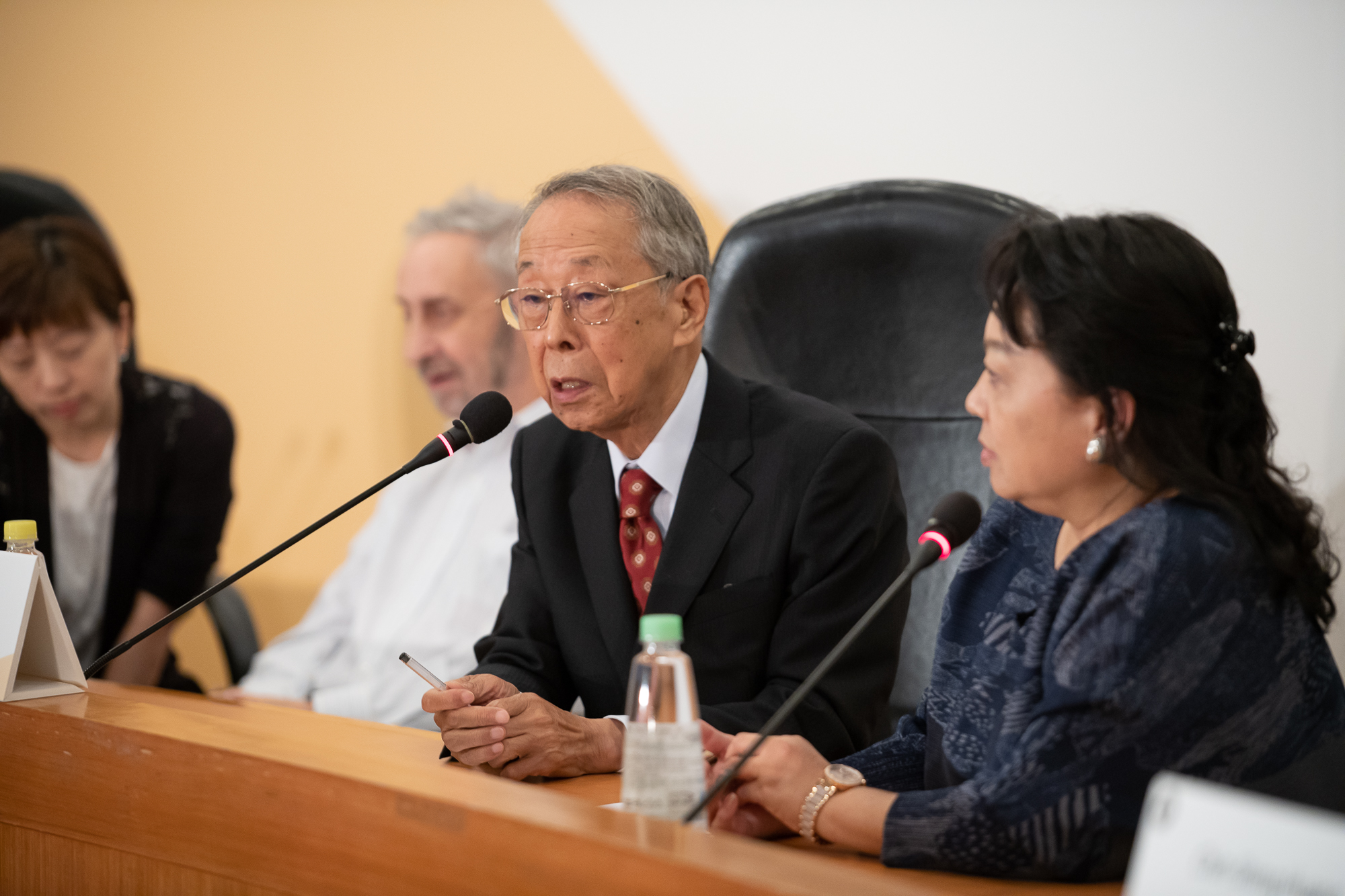
In the middle section of the speech, Prof. Shiba mentioned that the construction of the Grand Canal in the Sui Dynasty made it possible for many businesses to expand to even the outlying areas of the empire. As the time and cost required to transport goods were reduced drastically, more commodities can be delivered to different parts of the country, boosting its inter-regional trade and social interaction. Because waterborne transport gave rise to market towns, manufacturers of local specialties can amass a fortune by monopolizing specific markets, and the patterns of local economic activities were transformed accordingly. In addition, the difference in resources northern and southern China had unbalanced the overall economic development and changed the political clout the north and the south carried.
Nevertheless, not all changes were effected by merchants. Upon concluding his lecture, Prof. Shiba pointed out that the Tang and Song Dynasties owed many of these successes to the combination of the powers of public and private enterprises as well as the improvement in state finance, in policies on taxation and even in military expenditure, all of which, initiated by the government, in turn enhanced the integration of the state’s resources and allowed them to be used with higher efficiency. Prof. Shiba’s talk gave us a clear illustration of how citizens living in a period when bureaucracy still held sway can bring about political reform by creating economic prosperity.